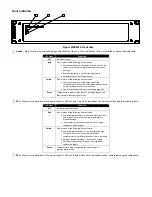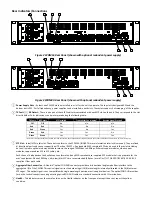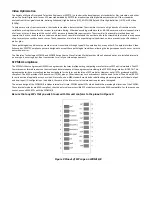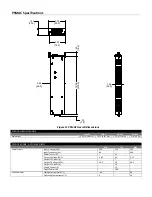
Video
Optimization
The
Society
of
Motion
Picture
and
Television
Engineers,
or
SMPTE,
is
a
leader
in
the
development
of
standards
for
film,
television,
and
other
video.
The
Serial
Digital
Interface
or
SDI,
was
standardized
by
SMPTE
for
broadcast
quality
digital
video
transmission.
Other
standards
evolved
from
this
original
standard,
defining
Enhanced,
High
‐
definition
(HD),
3G
‐
SDI
(1080p)
and
Ultra
High
‐
definition
(UHD),
or
4K
video
(2160p).
To
help
ensure
error
‐
free
transmission,
the
standards
include
a
data
scrambler
/
descrambler
to
create
a
high
density
of
transitions
in
the
serial
data,
making
it
easier
for
the
receiver
to
maintain
timing.
Where
an
encoding
method
such
as
8B
‐
10B
ensures
a
minimal
sequential
run
of
all
ones
or
zeros,
it
does
so
at
the
cost
of
a
25%
increase
in
bandwidth
requirements.
The
scrambler
/
descrambler
method
does
not
require
this,
but
as
a
result
there
are
certain
combinations
of
scrambler
state
and
the
next
data
bits
to
be
scrambled
that
result
in
a
sequence
of
up
to
twenty
consecutive
ones
or
zeros.
These
sequences
are
referred
to
as
pathological
conditions,
and
are
present
in
specific
shades
of
pink
or
grey.
These
pathological
conditions
may
create
errors
in
transmission
through
typical
AC
coupled
optics,
or
any
other
AC
coupled
interface.
Video
Enhanced
or
SMPTE
Compliant
optics
are
designed
to
accept
these
pathological
conditions,
allowing
the
longer
sequences
of
ones
or
zeros
to
pass
without
error.
The
Fiberplex
Technologies
WDM16
and
WDM8
Active
Coarse
Wave
Division
Multiplexer
has
Video
Enhanced
optics
pre
‐
installed
internally
on
every
port,
ensuring
error
‐
free
transmission
for
all
of
your
video
requirements.
SFP
MSA
Compliance
The
SFP
Multi
‐
Source
Agreement
(MSA)
is
an
agreement
that
was
drafted
among
competing
manufacturers
of
SFP
optical
modules.
The
SFF
Committee
was
formed
to
oversee
the
creation
and
maintenance
of
these
agreements
including
the
SFP
MSA
designated
as
INF
‐
8074i.
This
agreement
describes
a
mutually
agreed
upon
standard
for
the
form
and
function
of
SFP
modules.
However,
not
all
SFPs
produced
are
MSA
compliant.
The
MSA
provides
for
a
transceiver
(TX/RX)
pinout.
Other
industries
such
as
broadcast
had
the
need
for
dual
TX
and
dual
RX
SFP
for
uni
‐
directional
applications
such
as
video.
Naturally,
a
non
‐
MSA
standard
was
introduced
allocating
pinout
assignments
for
dual
output
and
dual
input
I/O
configurations.
In
addition,
the
some
of
the
internal
serial
communication
pins
were
reassigned.
The
unique
design
of
the
WDM16/8
includes
internal
multi
‐
rate,
CWDM
optical
SFPs
which
handle
the
wavelength
allocation
of
the
CWDM.
These
internal
modules
are
MSA
compliant,
thus
the
external
user
accessible
SFP
modules
must
also
be
MSA
compatible.
For
this
reason
you
cannot
use
non
‐
MSA
SFPs
with
the
WDM16/8.
Be
sure
that
any
SFPs
that
you
wish
to
use
with
this
unit
conform
to
the
pinout
in
Figure
9.
Figure
9
Pinout
of
SFP
cage
on
WDM16/8
Содержание WDM16
Страница 1: ...USER MANUAL Active Wave Division Multiplexer WDM16 WDM8A WDM8B...
Страница 2: ......
Страница 13: ...REMOVE CAP REPLACE FUSE SCREWDRIVER SLOT Figure 6 Replacing the Fuse in the PSMAC...
Страница 19: ......
Страница 23: ......
Страница 24: ...WDMUM 1401 18040 412 Guilford Rd Annapolis Junction MD 20701 fiberplex com clients fiberplex com 301 604 0100...







































